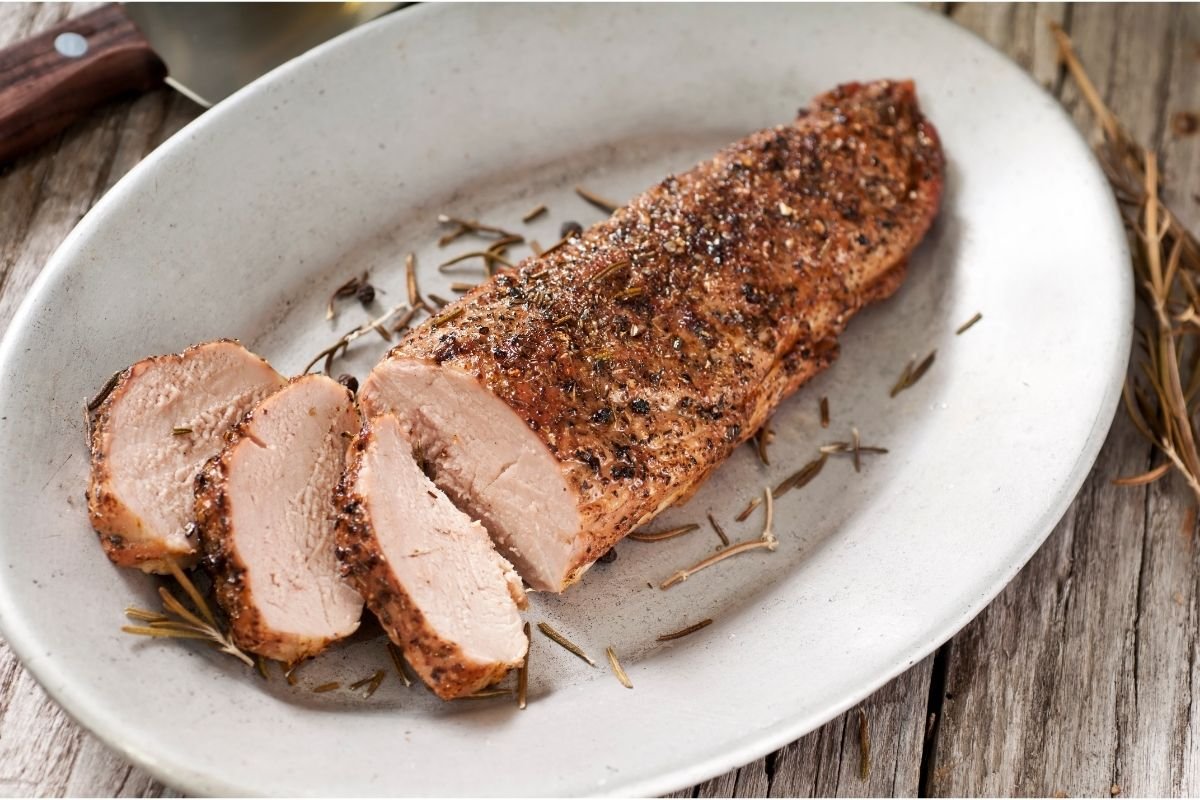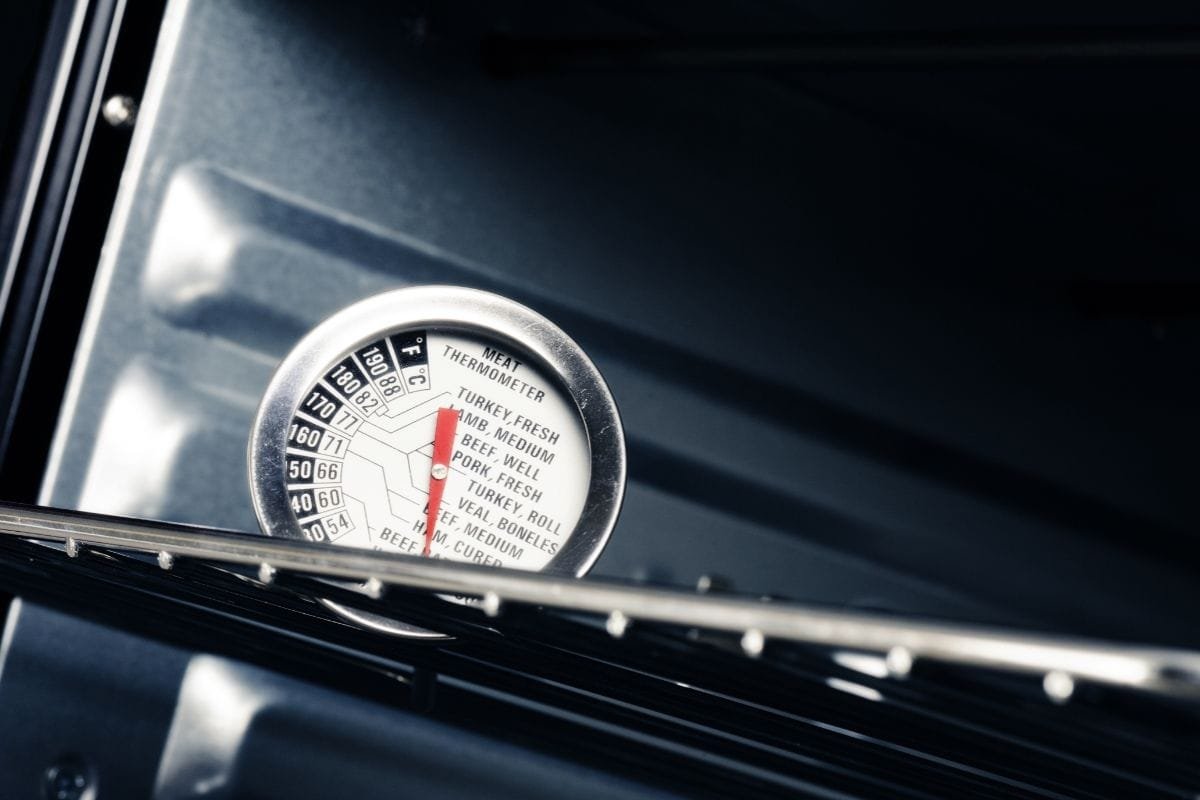You’ve followed the recipe of your latest culinary masterpiece to the T: pork tenderloin, marinated for a whole day and a night in asian-style ginger and soy sauce. Hoo boy.
The whole family knows it’s coming. After all, you’ve talked of nothing else all week.

From the kitchen, you can hear the rhythmic pounding of the silverware on the table, their feet on the floor; building to a maddening frenzy. This is it; this is your moment.
And yet here you stand: lips numb with panic, knife in trembling hand, at what should be the summit of your crowning glory.
Your tenderloin is still PINK in the middle.
How could this be? The oven was hot enough, you made sure of it. The thermometer sticking out of the meat is showing the right temperature.
Everything went according to plan. But this can’t be right…can it? Could it all have been for nought?
You start to sweat.
The pounding in the next room fills your head- and now it’s joined by voices; animal, crazed. Pork, they cry. Pork.
You can’t think. The noise is deafening. The knife clatters to the floor. From far away you hear a scream that sounds strangely like your own.
The last thing you see before you black out is your pink tenderloin laughing at you. It turns over and speaks. It says “You should have read the article below for more information”.
Is Pink Pork Safe to Eat?
Despite your gut reaction, it certainly can be! So long as the center of the pork has reached 145 degrees Fahrenheit, it is cooked and perfectly safe to eat.
Making sure that your pork is white all the way through is actually a popular misconception caused by decades of bad health advice, and runs the risk of drying it out.
Remember, even well-done pork can keep a slight pink hue.
What is a Pork Tenderloin?
Tenderloin, as the name suggests, is a very tender cut of meat taken from the back of the pig around the spine.
It’s a muscle group that isn’t really worked, so the meat is extremely tender and mild-tasting.
Flavor is given to this cut with marinades and sauces, and by preserving the juiciness of the meat while cooking.
This would explain why the tenderloin recipe you followed has resulted in a pink meat- this dish is delicate and suffers greatly from being overcooked.
At What Temperature Is Pork Safe to Eat?
To find the balance between preserving the dish by not overcooking it, and avoiding becoming ill from undercooking it, you are best off purchasing a meat thermometer.
These extremely useful devices can be inserted through the meat to the center and give you a reading in Fahrenheit or Celsius.
Buy one for quite cheap, and watch how it transforms cooking delicate meats like turkeys and lamb.
Once the center of your pork tenderloin has reached a temperature of 145 degrees Fahrenheit/63 degrees Celsius, it is safe to eat.
That is the recommendation of the USDA, the regulatory body for food health standards in the US.
If you’re still squeamish about pink pork, then you could leave it for a few minutes longer- but once that internal temperature exceeds 150 degrees Fahrenheit, you are simply running the risk of drying out the pork and ruining the tenderloin.
The misconception about cooking pork until it was white was actually caused by the USDA: for years, their advice was that pork should be cooked until it was 160 degrees Fahrenheit.
This advice doubtless ruined millions of tenderloin dinners until it was formally corrected in 2011; but there still remains a public perception of pork as a tasteless, dry meat that has to be cooked until it is white to be safe.
Similar things have been said about turkey, which is also meant to be delicately cooked- many a Thanksgiving or Christmas dinner ruined by overcooking.
Luckily, better food advice and technology such as the meat thermometer will eventually put these poor culinary practices into the past.
How To Use a Meat Thermometer

A meat thermometer is absolutely essential to getting meat to cook perfectly, and is especially useful with pork.
Pork is generally considered a perfect storm of difficulty: It is dangerous when undercooked, it is ruined when overcooked, and its color is not a credible gauge of whether it is cooked or not, like with most other meats. The best way of being sure either way is with a thermometer.
A meat thermometer can be inserted through to the center of meat to give an accurate reading of internal temperature.
If you know at which temperature what specific meat is safe to eat at, then you need never overcook your meat again.
For an accurate reading, insert deeply into the thickest part of the meat. Avoid making contact with bone, fat or gristle so that you can be sure that the reading is accurate.
Is It Safe for Pork Tenderloin to Be Pink in the Middle After Cooking, Like Turkey Burgers?
Yes, it is safe for pork tenderloin to be slightly pink in the middle after cooking, just like turkey burgers. The key is to use a meat thermometer to check the internal temperature. For pork, it should reach 145°F, and for turkey burgers, it should reach 165°F. That’s how to check turkey burger done.
What Does it Mean When Pork is Pink?
If you eat chicken, you know what color it shouldn’t be. If you enjoy cooking beef steaks, then you know exactly what color you prefer it.
Many meats allow you to know how done they are simply by how they appear Pork doesn’t work in the same way.
Many factors will affect how pork’s color react when cooked, and even well-done or overcooked pork can still retain a slight pink hue.
If you approach pork in the same manner, you will simply ruin your pork.
If your cut of pork has a high pH count, it may remain extremely pink even when it is perfectly cooked.
This can unnerve many people who aren’t used to pork or have only ever overcooked it, especially when it’s being carved into slices in front of them.
Pre-cooked, vacuum-sealed meats will also act in odd ways when opened.
‘Color reversion’ may cause pork cooked and sealed to take on particularly bright pink when re-exposed to air.
Not to sound like a snob, but the best way to eat meat is to purchase them fresh from a reputable butcher’s, or at least a decent cut from a quality grocery store. Don’t settle for substandard products.
Preparing Pork Tenderloin
Before purchasing a pork tenderloin, make sure that the meat is fresh by checking it is a nice vibrant pink.
There should be no signs of gray discoloration- this implies that your meat has been affected by oxygen, which means that it is not fresh and has likely expired.
Do not take any risks when it comes to pork.
Remove the silverskin- the gray tissue which runs across your tenderloin. Insert a knife beneath it, then peel it off.
Pat the meat dry with paper towels before seasoning or applying a marinade. Don’t wash the meat; this just spreads juices and bacteria, contaminating your kitchen.
When seasoning or applying a marinade to your tenderloin, don’t spare the horses.
This is an extremely mild piece of meat, so choose some nice strong flavors that will compliment the juicy meat.
You’ll regret not doing so if you cook it only to find that the whole ensemble is a bit bland.
Pork has a strong history in Asian cuisine. Take inspiration from these recipes, using strong flavors like ginger, star anise, black vinegar and soy sauce to really get things going.
How To Tell When Pork Is Done
With some meats, people reliably use the method of cutting into the meat to check if it is cooked all the way through.
This isn’t a good idea with pork tenderloin for a number of reasons. For one, as we’ve tried to drum into you, the color of pork is no indicator of how done it is.
Secondly, this delicate meat will begin to dry out if you put it back into the oven or on the grill with its brand new nicks or cuts; right into the middle.
A meat thermometer is the way forward. The needle of the thermometer doesn’t cause any intrusive damage to your delicate dish in the same way that cutting it open with a knife will.
Simply insert it and take the temperature. Once the reading is 145 degrees Fahrenheit/63 degrees Celsius, your meat is cooked.
We believe it is important that you remove your pork from the oven or grill at this point.
Like other meats, the internal heat within the tenderloin will continue to cook it even after it has been removed. As with turkey, you must factor this into your cooking plans.
Drizzle the pan juices over the tenderloin to keep it moist, and slice it into medallions to serve.
Refrigerate your leftovers- pork is a dangerous meat, and if it has been left out at room temperature for longer than two hours (less on a hot day), consider it lost. Just throw it out, don’t take any chances.
Good luck with all your preparations! Happy eating.
